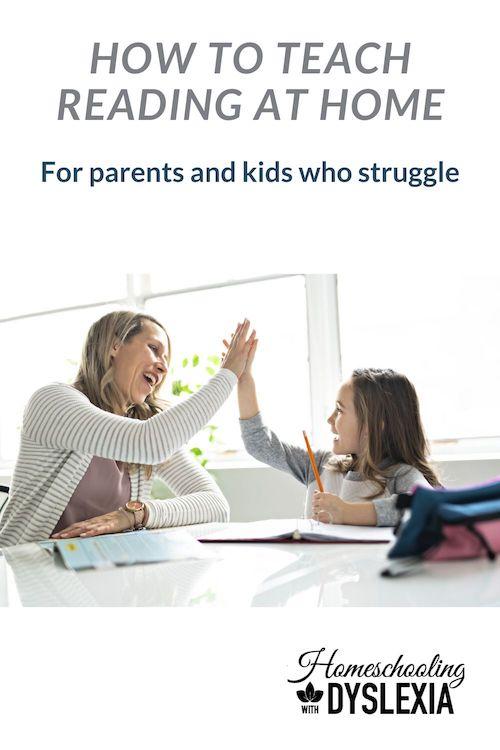You don’t need to be a trained dyslexia tutor to teach reading at home.

Do you remember learning to read? I don’t.
I don’t remember learning phonics, I don’t remember learning spelling rules, and I never even knew that there were intelligent people who struggled with reading and spelling – at least until my first child was diagnosed with dyslexia at about 7 years old.
That diagnosis was the beginning of a huge period of learning for our family. That 7-year-old is in his 30s now and a successful yacht captain. I have learned a LOT along the way!
This site started as a resource for parents homeschooling struggling learners. Our kids are bright but struggle unexpectedly with certain academic activities like reading, spelling, writing, and sometimes math. About 50% of our kids also struggle with focus and organization.
The bottom line here is our kids are super smart but learn better in different ways. Ways that large classrooms can’t provide.
Read more about the benefits of homeschooling struggling learners here.
The Best Way to Teach Reading to Kids With Dyslexia
One of the most important things to learn as you set out to educate your kids with dyslexia, whether you are working with them over the summer break or you are a full time homeschooler, is to get the best curriculum for teaching reading and spelling.
Next, you’ll want to have a good understanding of how they learn. Remember, that kids who learn differently need to be taught differently.
A few things to know before getting started teaching reading.
Relax.
As a natural reader, I didn’t even remember learning how to read. I never realized that there were bright kids who struggled with things like reading and spelling. When my kids began to struggle with some of the most basic concepts of reading, I began to panic big time. So the first step on your list of things to do is to relax and know that 20% of the population are perfectly intelligent but do learn to read on a different schedule.
Speaking of schedules.
Natural readers learn to read well, naturally. One of my eight kids is wired this way. In fact, at five years old after the most elementary of reading lessons, she was able to crack the code of reading so-to-speak by casually picking up early readers in her spare time. After teaching five kids with dyslexia to read, this revelation had a strange effect on me. I actually grieved for a period of time. Knowing that 80% of kids can learn to read with fairly basic instruction and practice while mine struggled to remember basic rules that we had gone over sometimes for years, made me feel discouraged. Nevertheless, some kids learn to read on a different timetable. That’s just how it is. Having the right expectations are a big part of teaching reading.
You can read more about our family’s Dyslexia journey here.
About those expectations.
Here are a few things that you can expect when teaching reading to a struggler.
- They need lots of practice. It has been estimated that kids with learning differences like dyslexia need 10 times the amount of exposure to concepts as traditional learners. Don’t be surprised that they seem to forget what they seemed to know yesterday. They did forget. Just remind them and do some practice.
- Traditional reading programs don’t work. That’s because they don’t provide the kinds of teaching plus review that these kids need. Fear not, there a handful of excellent programs designed to use at home. No need to reinvent the wheel. At the end of this post, I’ll share my favorite reading resources.
- Make it multi-sensory. Any way you can think of to add other senses into their learning will help. The reason is that more areas of the brain are activated, making concepts stick sooner. This would be using their hands to touch, their ears to hear, and their eyes to see – all at the same time.
- They’re smart in different ways. Having your kids at home with you is an awesome opportunity to observe your kids’ real passions and interests. In fact, having the time and freedom to pursue these interests is one of the biggest benefits of homeschooling!
To learn more about different kinds of intelligence, read this series on Mulitple Intelligences.
Learn simple ways to incorporate interests for real and fun learning here.
Okay, so how do I teach reading?
1 . Start with a research-based, Orton-Gillingham reading program designed to use at home.
There are a variety of Orton-Gillingham (OG) reading programs designed to be used at home by parents. If you love to know the why behind things, you can learn more about the Orton-Gillingham approach and why it is so effective here.
Read my comparison of the top 4 Orton-Gillingham reading programs for use at home here.
2. Use the program faithfully at least 3 days per week. Orton-Gillingham programs can have a lot of moving parts. That is because using multi-sensory methods is a big part of these programs. Whichever program you choose, read this post to help you get to know your program and set it up for the most success: Read How to Prep for a Great Year of Reading here.
3. What to do if you have questions. All of the programs mentioned in this post have outstanding customer support. Really. If you are stuck, call them and ask. They have years of experience with these programs and are more than happy to help.
4. Remember to relax. This is hard for your kids. Smile. Remember what I said about schedules and adjust your expectations. If you’re like me and never struggled to read, try taking one of these dyslexia simulations. It will be much easier to be patient with this knowledge.
5. Talk to your kids about learning differences. Your kids are smart but learn differently. You can learn more about the signs of dyslexia here and learn more about the strengths of dyslexia here.
Consider buying my children’s book: What is Dyslexia?: A Parent’s Guide to Teaching Kids About Dyslexia. I wrote this book for kids ages 4-12 to help them to understand what they may be feeling about their learning and to make a point of teaching kids about the strengths of the dyslexic mind. Save 20% with code HELP20.
6. Get connected. You are not alone but you may feel like it at times. Finding online support groups is essential during these times. Connect with our Homeschooling WIth Dyslexia groups here:
- Homeschooling With Dyslexia Facebook Page: I share interesting articles about learning here daily.
- Homeschooling With Dyslexia Facebook Group: This is a newer group that allows for a more interactive environment. Ask questions. Share successes.
- Homeschooling With Dyslexia Instagram Page: Get peeks into our day-in-the-life school.





Homeschooling my 5th grader for the first time ever has been an eye-opener for me. I read through this article and can relate completely to all of it. Of crucial importance to me is figuring out right where I need to start as I don’t want to bore him with repeated info. He has received much OG therapy at school. I purchased the All About Reading Level 1 and it seems that he is beyond this level except with the last reading book. He stumbles and falls all over the material.
And yet, I have him read his religion text and he does well. He takes a long time reading it since he sounds out everything, but he gets the job done. His comprehension is good too.
I really need to know that I am not the only mom who 1. has no clue what she’s doing; 2. doesn’t see quite where her child fits in when taking an eval for which level to use; and 3. tries to keep the kiddo engaged, but he just doesn’t seem to want to homeschool but doesn’t want to return to school either.
The struggle is real for us.
Hi Mandy,
Your son is progressing but not fluent yet. Fluency is the last piece to come in reading. He is still mastering the rules so his reading is slow and choppy. Once you start AAR Level 2, you can add All About SPelling which is an excellent level of review. You are not alone and what you are experiencing is totally normal!
Here is an article on how to build fluency in dyslexic readers.
https://dev.homeschoolingwithdyslexia.com/building-reading-fluency-dyslexic-readers/